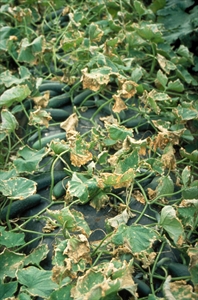Cucumber downy mildew
Pacific Pests, Pathogens, Weeds & Pesticides - Online edition
Pacific Pests, Pathogens, Weeds & Pesticides
Cucumber downy mildew (143)
Pseudoperonospora cubensis
Asia, Africa, North, South, and Central America, the Caribbean, Europe, Oceania. It is recorded from American Samoa, Australia, Federated States of Micronesia, Fiji, French Polynesia, Guam, New Zealand, Papua New Guinea, Samoa, Solomon Islands, Tonga, and Vanuatu.
Members of the cucumber family (cucurbits): cucumber, gourd, melon, pumpkin, squash, watermelon, zucchini.
The disease is caused by an oomycete, not a fungus, although much about the downy mildew is fungus-like. On cucumber and melon, yellow spots occur on the upper leaf surface (Photos 1&2). Later, these spots dry out, become brown, but remain limited by the leaf veins. Later still, spots may merge. In wet or humid conditions, a purple-grey downy growth can be seen on the underside of the spots (Photos 3&4). The leaves dry out, collapse and die (Photo 5).
The oomycete develops quickly during warm (18-23°C) wet weather, with fog or heavy dew increasing disease development. Spores, called 'sporangia', are produced on the leaves, and these produce swimming spores called 'zoospores' inside them. The zoospores germinate and infect through the natural openings of leaves. They need water for germination.
An important point about the biology of downy mildew is that it cannot live on dead plants. It survives between crops on volunteer cucurbits and weeds belonging to the cucurbit family. The disease is spread in wind and water splash. Long distance spread is possible on air currents if the humidity is high. However, the spores only survive a few hours in sunlight.
Downy mildew is an import disease, especially on cucumber, rockmelon and zucchini. In wet weather, it spreads rapidly, and is difficult to control. Fruits are not infected, but those that form are small, and do not ripen properly. The loss of leaves may result in sunscald of the fruit.
Look for round or angular spots on the top surface of the leaf, rapidly turning brown, but often limited by the leaf veins. Look to see the purple-grey, downy or felt-like growth on the underside of the leaves where the spores form. Incubate the leaves at 20-25°C and high humidity overnight to promote development of the spores.
CULTURAL CONTROL
Cultural control is important; there are a number of ways that it can be used to reduce the impact of the disease:
-
Irrigation: Avoid overhead irrigation; or irrigate early in the day to reduce the time when leaves are wet.
-
Plant density: Provide adequate spacing between staked plants, so that air movement between them dries leaves quickly.
-
Orientation: Plant rows of staked crops so as not to hinder prevailing air movement through the crop.
-
Time of planting: Where disease is common and severe, avoid planting at times of the year when environmental conditions are especially favourable to the disease, i.e., when it is wet and warm.
RESISTANT VARIETIES
There are tolerant varieties of cucumber, and also low levels of tolerance in some varieties of melon and watermelon. Note, the use of tolerant varieties may mean that fungicides are still needed when environmental conditions favour the disease.
CHEMICAL CONTROL
Both protectant and curative (systemic) fungicides are used to control this disease, even with tolerant varieties, when growing conditions favour the disease. If fungicides are needed, use:
- Protectant products: coppers, e.g., copper oxychloride; mancozeb; chlorothalonil.
- Systemic products: metalaxyl; phosphorus acid.
Note, resistance to metalaxyl exists, and it should only be used when environmental conditions favour the disease, or only when symptoms are first seen. At other times, protectant products should be used.
____________________
When using a pesticide, always wear protective clothing and follow the instructions on the product label, such as dosage, timing of application, and pre-harvest interval. Recommendations will vary with the crop and system of cultivation. Expert advice on the most appropriate pesticides to use should always be sought from local agricultural authorities.
AUTHOR Grahame Jackson
Information from Gerlach WWP (1988) Plant diseases of Western Samoa. Samoan German Crop Protection Project, Deutsche Gesellschaft für Technische Zusammenarbeit (GTZ) Gmbh, Germany; and (including Photos 1&5) Diseases of vegetable crops in Australia (2010). Editors, Denis Persley, et al. CSIRO Publishing; and from Quesada-Ocampo L (2018) Cucurbit downy mildew. Vegetable pathology factsheets. NC Extension. (https://content.ces.ncsu.edu/cucurbit-downy-mildew). Photos 2&3 Clemson University - USDA Cooperative Extension Slide Series, Bugwood.org. Photo 4 Jacquie (Wright) Kami, formerly Plant Pathologist, Secretariat of the Pacific Community, Suva, Fiji.
Produced with support from the Australian Centre for International Agricultural Research under project PC/2010/090: Strengthening integrated crop management research in the Pacific Islands in support of sustainable intensification of high-value crop production, implemented by the University of Queensland and the Secretariat of the Pacific Community.








